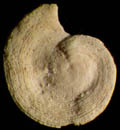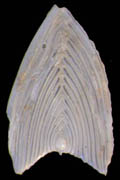Foraminifera
Dredging was one way that minute mollusks and Foraminfera were discovered on the Barbados-Antigua Expediton. Through the use of a sieve, fine sand and mud were separated from the larger objects. This sand was then placed in a canvas bag, and after the contents had dried, was picked over carefully. This method allowed for the discovery of specimens that often proved to be of greater interest than the larger objects.
 |
Genus Orbiculina collected from English Harbor beach, Antigua Foraminifera a very small single celled organisms that construct shells. They inhabit a wide range of marine environments, from the intertidal zone to the deep sea in all regions. |
 |
Genus Haplostiche collected from dredging station 67, Antigua The two major groups of foraminigera are benthic, which live in sea-floor sediments and planktic, which inhabit about the upper 300 feet of the ocean.
|
 |
Genus Frondicularia collected from dredging station 18, Antigua The shells of planktic and many benthic species are composed of calcite, the same mineral that sea shells are made from. Although most species are composed of calcite some create their shells from other minerals such as aragonite, silica, or cemented particles of sediment.
|